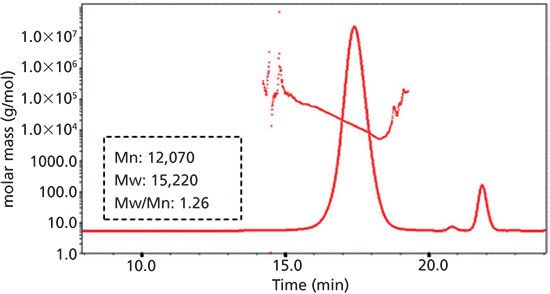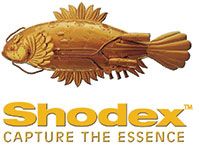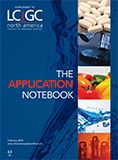Shodex LB-806M Column for Heparin Analysis
The Application Notebook
With the recent increase of polymer research, there has been a growing need for polymer analysis. The best way to determine the size and estimated molecular weight of polymers and biopolymers is achieved using size exclusion chromatography (SEC). Within SEC, the most commonly used detectors are differential detectors immediately followed by light scattering detectors. When coupling a light scattering detector with a refractometer, a very powerful mode of advanced detection for SEC analysis is the result. Specifically, multiangle light scattering (MALS) allows for the collection of useful information including the molecular weight, average number molecular weight, and distribution of the polymer.
Shodex promotes the LB-806M column with a durable polymer based packing material for aqueous SEC analysis. This column has also been shown to be suitable for light scattering due to the controlled column bleed. Shodex LB-806M is appropriate for polymer and biopolymer analysis, has demonstrated the determination of molecular weight for heparin.
The molecular weight of heparin, the naturally occurring biopolymer form of glycosaminoglycan, was determined by OHpak LB-806M, a column for aqueous SEC. Heparin is a naturally occurring polymer that can be used as an anticoagulant and can prevent deep vein thrombosis, pulmonary embolism, arterial thromboembolism, as well as treatment for heart attacks. The LB-800 series are compatible with multiangle light scattering (MALS) detector due to their negligible bleed. By minimizing the baseline noise level, the LB-800 series enables the MALS detect to detect a wider range of molecular weight compounds which are difficult to be detected by conventional columns.
Here, the molecular weight of heparin was analyzed using a Shodex OHpak LB-806M column with a light scattering detector. The sample contained a relatively narrow molecular weight dispersion of heparin polymers. This analytical condition can also be used with other detectors including RI.
Experimental Conditions
The analysis of containing heparin was accomplished using two Shodex OHpak LB-806M (8.0 mm ID × 300 mm ID, 13 µ) aqueous size exclusion chromatography columns suitable for light scattering detection. The column temperature was 30 °C and flow rate was 1.0 mL/min. The eluent conditions were 0.1 M NaNO3 aq. An injection volume of 100 µL of 0.1% heparin was used for the experiment. The HPLC system was coupled with MALS (multiangle light scattering) detector and a Shodex RI detector.
Results
Absolute molecular weight of heparin was determined by OHpak LB-806M, a column for aqueous SEC coupled with MALS detection (Figure 1).

Figure 1: The analysis of heparin using Shodex OHpak LB-806M.
Conclusions
Shodex LB-800 series are compatible with multiangle light scattering (MALS) detection. By minimizing the baseline noise level, the LB-806M enabled MALS detection to detect low molecular weight compounds which are difficult to be detected by conventional columns. The polymer-based packing material with a controlled particle size provides excellent chemical stability and minimum deterioration over extended periods of time.

Shodex™/Showa Denko America, Inc.
420 Lexington Avenue, Suite 2335A, New York, NY, 10170
tel. (212) 370-0033 x109, fax: (212) 370-4566
Website: www.shodexhplc.com

Characterizing Plant Polysaccharides Using Size-Exclusion Chromatography
April 4th 2025With green chemistry becoming more standardized, Leena Pitkänen of Aalto University analyzed how useful size-exclusion chromatography (SEC) and asymmetric flow field-flow fractionation (AF4) could be in characterizing plant polysaccharides.
Investigating the Protective Effects of Frankincense Oil on Wound Healing with GC–MS
April 2nd 2025Frankincense essential oil is known for its anti-inflammatory, antioxidant, and therapeutic properties. A recent study investigated the protective effects of the oil in an excision wound model in rats, focusing on oxidative stress reduction, inflammatory cytokine modulation, and caspase-3 regulation; chemical composition of the oil was analyzed using gas chromatography–mass spectrometry (GC–MS).

















